Are you ready to unlock the potential of your small outdoor oasis? Look no further than this comprehensive small garden planting guide that will help you get started on your green-thumb journey today!
Introduction
Starting a vegetable garden is a rewarding and enjoyable endeavor, even in a small space. Whether you have a tiny backyard, a balcony, or even just a windowsill, you can create a beautiful and productive garden. This small garden planting guide will provide you with all the information you need to start growing your own fresh vegetables and herbs, no matter how limited your space may be.
Key Takeaways:
- Choosing the right location is crucial for a successful small garden.
- Start small and gradually expand your garden as you gain experience.
- Select easy-to-grow vegetables that you and your family enjoy eating.
- Plant vegetables at the appropriate times based on your regional climate.
- Create a garden map and plan your beds for efficient use of space.
Choosing the Right Location for Your Small Garden
The success of your small garden starts with choosing the perfect location and designing your space to maximize its potential. When it comes to small gardens, selecting the right location is crucial for the growth and productivity of your plants. Here are some gardening tips for small spaces to help you create an ideal environment for your garden:
- Find a sunny spot: Most vegetables thrive in full sunlight, so choose a location that receives at least 6 to 8 hours of direct sunlight per day. Avoid areas that are shaded by buildings or tall trees.
- Ensure proper drainage: The soil in your small garden should drain well and not stay wet. Poor drainage can lead to root rot and other issues. If the soil in your chosen location is heavy or clayey, consider adding organic matter to improve its texture and drainage.
- Consider wind exposure: Strong winds can damage delicate plants and hinder their growth. Look for a spot that is sheltered from strong gusts, such as against a wall or near a fence.
- Assess soil quality: Nutrient-rich soil is essential for healthy plant growth. Test the soil in your chosen location to determine its pH level and nutrient content. Amend the soil if necessary, adding compost or organic fertilizers to improve its fertility.
By taking these factors into consideration, you can create an optimal environment for your small garden. Remember, proper planning and preparation are key to a successful gardening experience.
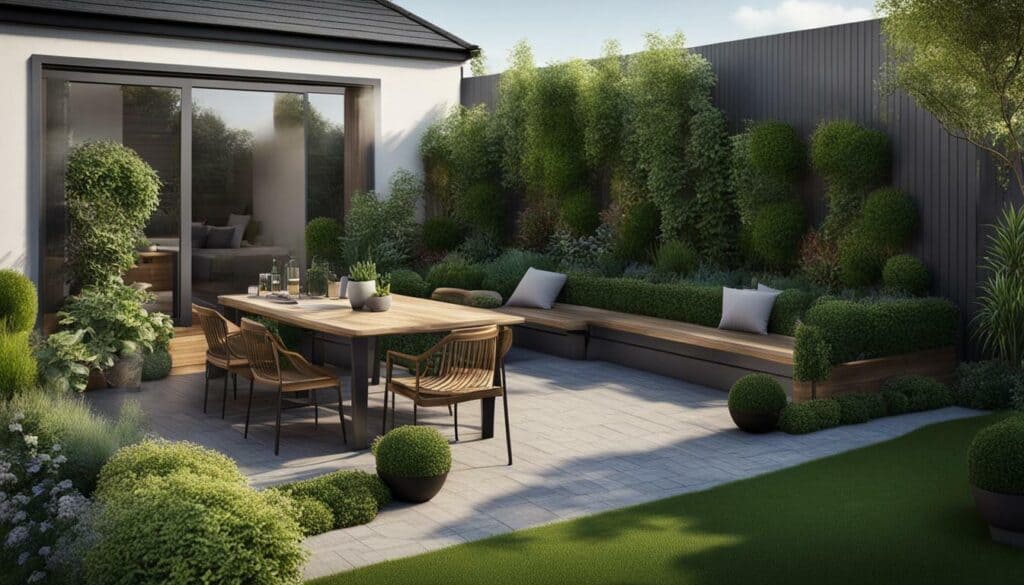
Designing Your Small Garden
Once you’ve chosen the right location for your small garden, it’s time to design the layout of your space. This is where creativity comes into play, as you find innovative ways to maximize the available area. Consider the following small garden design tips:
- Utilize vertical space: If you have limited ground space, make use of vertical gardening techniques. Install trellises, hanging baskets, or wall-mounted planters to grow vining vegetables or trailing flowers.
- Create raised beds: Raised beds are an excellent option for small gardens as they help define growing areas and provide better soil drainage. They also make gardening more accessible, particularly for those with limited mobility.
- Introduce container gardening: Containers are a versatile and space-saving solution for small gardens. Choose pots or planters of various sizes and shapes to add visual interest. Mix and match different plants to create an eye-catching display.
Remember to consider aesthetics when designing your small garden. Choose plants that complement each other in terms of color, texture, and height. Creating a visually appealing garden will enhance your overall gardening experience.
With the right location and thoughtful design, your small garden can be a beautiful and productive oasis. Stay tuned for the next section of our ultimate small garden planting guide, where we will explore how to prepare the soil for planting.
Preparing the Soil for Planting
Before you start planting, it’s essential to prepare your soil to create the ideal growing conditions for your vegetables and herbs. Proper soil preparation is crucial for ensuring healthy plant growth and maximizing yields. Here are some steps to get your soil ready:
- Clear the area: Remove any weeds, rocks, or debris from the planting area. Weeds compete with your plants for nutrients and water, so it’s important to eliminate them beforehand.
- Test the soil: Conduct a soil test to determine its pH level and nutrient content. This will help you understand if any amendments are needed to optimize the soil conditions. You can easily find DIY soil test kits or send a soil sample to a local extension service for a more detailed analysis.
- Amend the soil: Based on the results of the soil test, add necessary amendments to improve the soil quality. Common amendments include organic matter like compost, well-rotted manure, and peat moss. These additions will enhance soil structure, drainage, and fertility.
- Loosen the soil: Use a garden fork or tiller to loosen the soil to a depth of 8-12 inches. This will allow plant roots to penetrate easily and access nutrients and water more efficiently.
- Add mulch: Apply a layer of organic mulch, such as straw or wood chips, to help conserve moisture, suppress weeds, and moderate soil temperature.
Remember, different vegetables and herbs have specific soil requirements. Some may prefer slightly acidic soil, while others thrive in a more alkaline environment. It’s important to research and understand the specific needs of the plants you’re growing to provide them with the best conditions for success.
Soil Preparation Tips
Here are a few additional tips to keep in mind when preparing your soil:
- Rotate your crops: To prevent soil depletion and reduce the risk of pest and disease buildup, practice crop rotation. This involves planting different vegetable families in different areas of your garden each year.
- Consider raised beds or containers: If you have limited space or poor soil quality, consider using raised beds or containers. These allow you to have more control over soil composition and drainage.
- Watering: After planting, water the soil thoroughly to help settle it around the roots. Provide regular irrigation as needed to maintain consistent moisture levels.
By taking the time to prepare your soil properly, you’ll create a solid foundation for a bountiful and flourishing small garden.
| Vegetable | Soil pH Range | Preferred Soil Type |
|---|---|---|
| Lettuce | 6.0-7.0 | Well-draining loam |
| Tomatoes | 6.0-7.0 | Sandy loam |
| Carrots | 5.5-7.0 | Sandy or loamy soil |
| Basil | 6.0-7.5 | Well-draining loam |
Remember, proper soil preparation is the key to a successful small garden. Take the time to understand the needs of your plants and make the necessary amendments to create the perfect growing environment. With healthy soil, you’ll be on your way to enjoying a thriving vegetable and herb garden in no time.
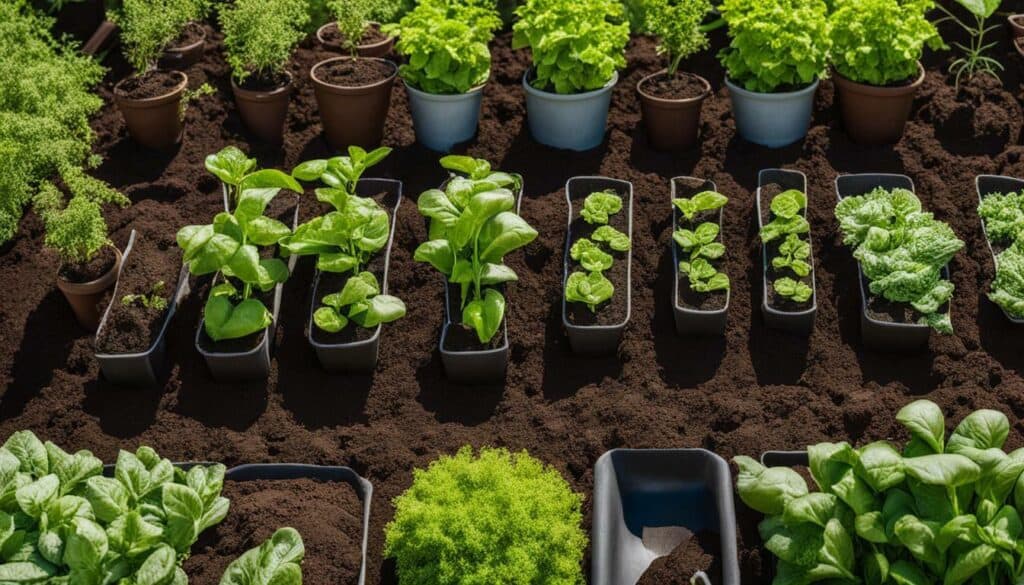
Determining the Size of Your Small Garden
When it comes to small gardens, starting with a manageable size is key. Let’s explore some creative planting ideas, including the popular option of container gardening.
Container gardening is perfect for small spaces, as it allows you to maximize your planting area by using pots, planters, and hanging baskets. You can grow a variety of vegetables, herbs, and even flowers in containers, making it a versatile and space-saving option. Plus, containers offer the flexibility to move your garden around if needed, ensuring optimal sunlight exposure for your plants.
Another great planting idea for small gardens is vertical gardening. By utilizing trellises, stakes, or even a dedicated vertical garden system, you can grow plants vertically, taking advantage of the vertical space in your garden. This is particularly useful for vining vegetables like cucumbers and squash, as well as climbing flowers like morning glories and sweet peas.
Additionally, raised bed gardening is a popular choice for small gardens. Raised beds provide several benefits, including improved soil drainage, better weed control, and easier access for planting and maintenance. With raised beds, you can create defined planting areas that are visually appealing and organized. You can even build raised beds in unconventional spaces like patios or balconies, allowing you to garden in areas with limited or no soil.
To summarize, determining the size of your small garden involves considering various creative planting ideas like container gardening, vertical gardening, and raised bed gardening. These options allow you to make the most of your limited space while still enjoying a productive and beautiful garden. Whether you choose to grow vegetables, herbs, or flowers, there are plenty of opportunities to create a thriving garden in a small area.
| Advantages of Container Gardening: | Advantages of Vertical Gardening: | Advantages of Raised Bed Gardening: |
|---|---|---|
|
|
|
“Gardening is the art that uses flowers and plants as paint, and the soil and sky as canvas.” – Elizabeth Murray
Vertical Gardening Tips:
- Choose plants that have a natural inclination to climb or trail.
- Provide sturdy support structures such as trellises or stakes.
- Consider the weight of the plants and the vertical structure to ensure stability.
- Regularly prune and train the plants to encourage upward growth.
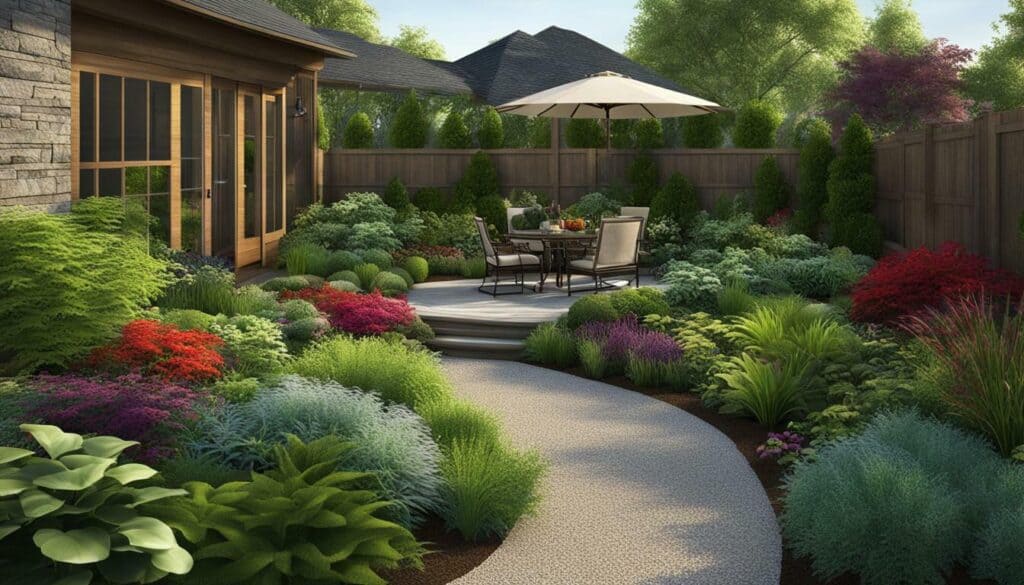
Selecting the Right Vegetables for Your Small Garden
It’s time to dive into the exciting world of vegetable gardening! Let’s explore some easy-to-grow vegetables that thrive in small garden spaces.
When it comes to selecting vegetables for your small garden, it’s important to choose plants that are not only productive but also well-suited for limited space. Here are some great options:
- Lettuce: This leafy green is perfect for small gardens as it can be grown in containers or even in between other plants. Plus, you can harvest it as needed, making it a versatile choice.
- Green beans: These climbing vegetables can be trained to grow on trellises, saving valuable ground space. They are prolific producers and provide a bountiful harvest.
- Radishes: Radishes are known for their quick growth and are ideal for small gardens. They can be sown directly in the ground or in containers, and their crunchy texture and peppery flavor make them a tasty addition to salads and sandwiches.
- Tomatoes: While tomatoes can take up more space, they can still be grown in compact varieties or as indeterminate plants trained on stakes or cages. They are a staple in many home gardens and offer an array of flavors and colors.
- Zucchini: These prolific squash plants can produce an abundance of fruit in small spaces. Choose bush varieties for compact growth or trellis them to save even more space.
These are just a few examples of vegetables that do well in small gardens. Remember to consider your preferences, available space, and the specific growing conditions in your area when making your choices.
Are Flowers a Good Addition to Your Small Garden?
When planning your small garden, don’t forget about the beauty and color that flowers can add. Flowers not only attract pollinators but also create an inviting and vibrant space.
Some flowers that are great for small gardens include:
- Marigolds: These brightly colored flowers not only add beauty to your garden but also help deter pests.
- Zinnias: Zinnias come in a variety of colors and are easy to grow from seed. They are perfect for adding pops of color to your garden.
- Petunias: These popular annuals are available in many colors and varieties, from cascading to upright forms. They are excellent for containers and hanging baskets.
By incorporating flowers into your small garden, you can create a visually stunning space that brings joy and attracts beneficial insects.
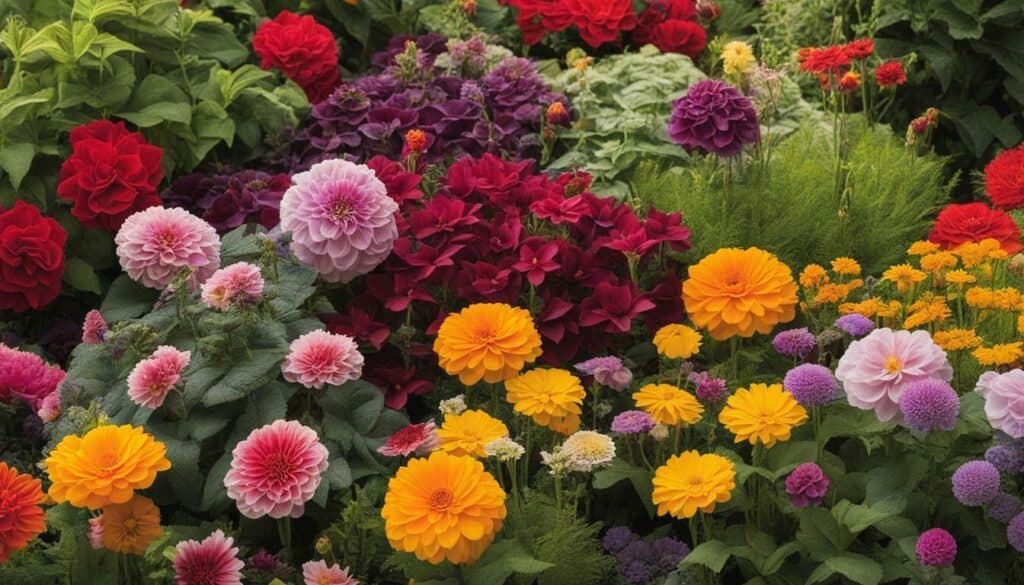
| Vegetable | Space Required | Harvest Time |
|---|---|---|
| Lettuce | 4-6 inches apart | 30-45 days |
| Green Beans | 4-6 inches apart | 50-60 days |
| Radishes | 2-4 inches apart | 20-30 days |
| Tomatoes (by transplant) | 24-36 inches apart | 60-85 days |
| Zucchini | 24-36 inches apart | 50-60 days |
With these easy-to-grow vegetables and colorful flowers in your small garden, you’ll have a thriving and visually appealing space that will bring you joy and a plentiful harvest.
Determining the Best Planting Times
Timing is key when it comes to planting vegetables. Let’s explore how to determine the best planting times for your small garden based on your location.
Before you start planting, it’s important to know your USDA Plant Hardiness Zone and the specific frost dates for your region. This information will help you understand the length of your growing season and determine when to start planting each vegetable.
Consult a gardening calendar customized for your local area to find the recommended planting dates for different vegetables. These calendars are usually based on historical climate data and provide valuable guidance on when to sow seeds or transplant seedlings.
Stagger your plantings to ensure a continuous harvest throughout the season. This means planting a portion of your seeds or seedlings every few weeks so that you have a steady supply of fresh produce rather than a sudden abundance.
| Vegetable | Spring Planting | Fall Planting |
|---|---|---|
| Lettuce | 2-4 weeks before the last frost date | 6-8 weeks before the first frost date |
| Tomatoes | Transplant after the last frost date | – |
| Carrots | 2-4 weeks before the last frost date | – |
| Green Beans | After the last frost date | – |
| Zucchini | 2-3 weeks after the last frost date | – |

By following these guidelines and considering your specific location, you can determine the best planting times for your small garden. Remember to check your frost dates, consult local gardening resources, and adjust your planting schedule accordingly. Happy gardening!
Creating a Garden Map and Planning Your Beds
Before you get your hands dirty, it’s crucial to create a garden map and plan the layout of your beds for optimal planting in your small garden. By carefully designing your garden space, you can maximize productivity, ensure proper sunlight exposure, and easily navigate through your plants.
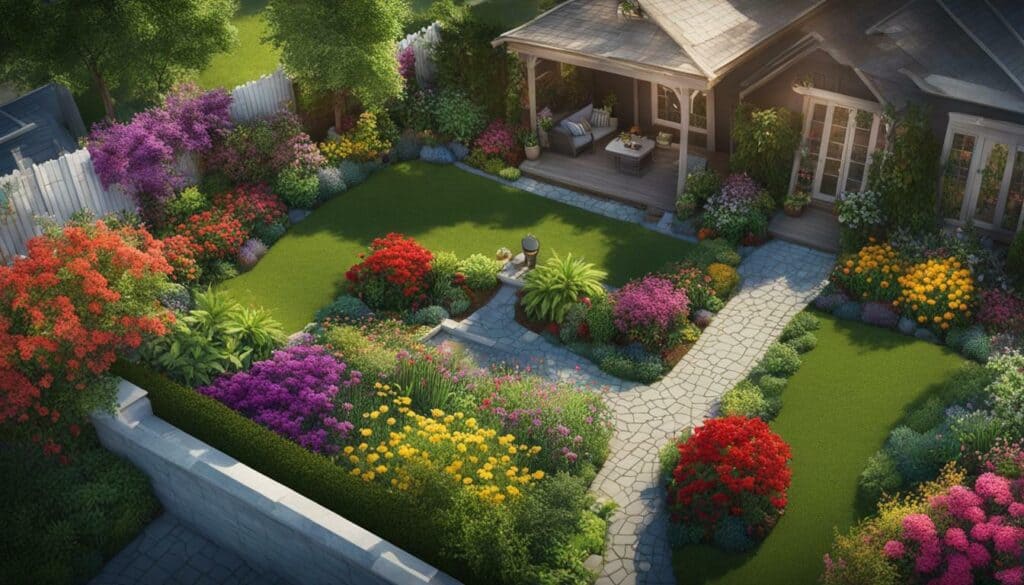
Start by measuring the dimensions of your garden area and sketching it out on graph paper or using a digital design tool. This will give you a clear visual representation of the available space and help you plan how to arrange your beds.
Consider the following factors when creating your garden map:
- Sunlight: Observe how the sun moves across your garden throughout the day and identify areas that receive the most sunlight. Place sun-loving plants, like tomatoes and peppers, in these spots.
- Shade: If you have areas that are shaded for a significant portion of the day, plan to grow shade-tolerant crops such as lettuce, spinach, and herbs.
- Accessibility: Leave enough space between beds to allow for easy access and maintenance. This will make it easier to tend to your plants and harvest your vegetables.
Once you have determined the layout of your garden, it’s time to plan your beds. Raised beds are a popular choice for small gardens as they make it easier to control soil quality and drainage. Consider using materials like untreated wood, brick, or even recycled containers to create your raised beds. Make sure the beds are wide enough to comfortably fit your plants and leave room for growth.
Example Garden Map:
| Bed | Vegetables |
|---|---|
| Bed 1 | Tomatoes, Peppers, Basil |
| Bed 2 | Lettuce, Spinach, Radishes |
| Bed 3 | Carrots, Beets, Onions |
Remember to rotate your crops each year to prevent the buildup of pests and diseases in the soil. A well-planned garden map can help you keep track of where each vegetable was planted, making crop rotation easier.
With a carefully thought-out garden map and bed plan, you’ll set yourself up for a successful and enjoyable gardening experience in your small garden.
Starting Seeds or Buying Transplants
Ready to get your garden growing? Let’s explore the pros and cons of starting seeds indoors and buying transplants for your small garden.
Starting seeds indoors is a cost-effective option that allows you to have a wider variety of plants. You have complete control over the growing conditions and can start plants earlier in the season. Plus, it’s a great way to engage kids in the gardening process. However, it requires more time, patience, and space to set up seed trays, provide proper lighting, and monitor seedlings.
On the other hand, buying transplants from a nursery saves you time and effort. Transplants are already established plants, ready to be planted directly into your garden. They give you a head start and ensure a more predictable harvest. However, the options may be limited, and you’ll have less control over the quality and health of the plants.
So, which option is best for you? It depends on your time, resources, and personal preferences. If you enjoy the process of nurturing plants from seeds and have the space and resources to do so, starting seeds indoors may be a rewarding experience. But if you prefer a quick and convenient start, buying transplants is a hassle-free option.
| Starting Seeds Indoors | Buying Transplants |
|---|---|
| Greater variety of plants | Convenient and time-saving |
| Complete control over growing conditions | Predictable harvest |
| Engaging activity for kids | Less setup and monitoring |
| Requires more time, patience, and space | Options may be limited |
Ultimately, the choice between starting seeds indoors and buying transplants depends on what works best for your small garden and your gardening goals. Whichever method you choose, the most important thing is to enjoy the journey and savor the experience of nurturing your own plants.
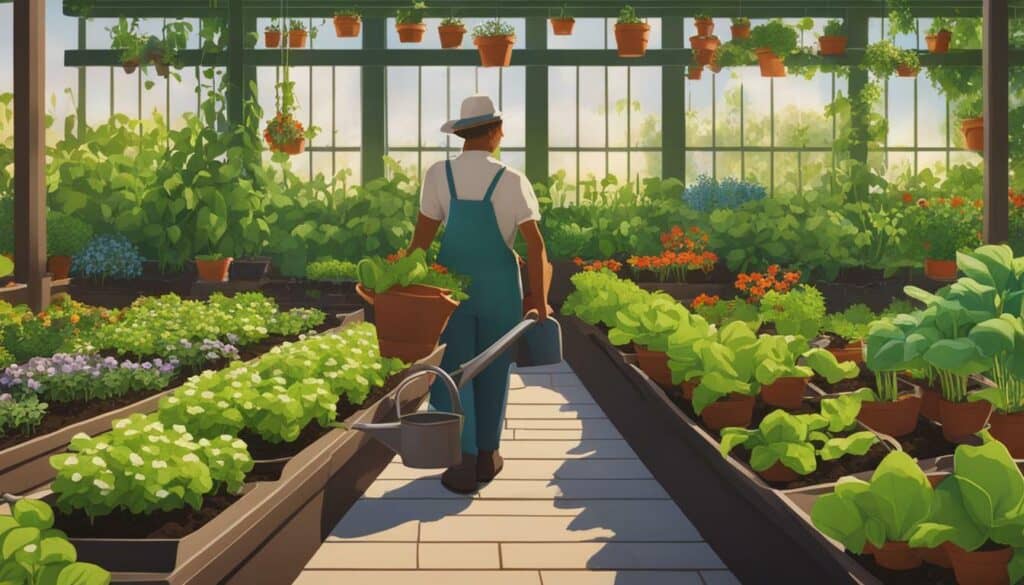
Essential Tools and Accessories for Your Small Garden
To ensure your small garden thrives, you’ll need a few key tools and accessories. Let’s explore what you’ll need to get started.
Gardening Tools
Having the right tools makes gardening easier and more enjoyable. Here are some essential gardening tools for your small garden:
- Garden gloves: Protect your hands from dirt, thorns, and blisters.
- Trowel: A small hand tool for digging and planting.
- Pruning shears: Use them for trimming and shaping plants.
- Garden fork: Helps loosen soil and remove weeds.
- Rake: Use it to level the soil and remove debris.
- Watering can: Make sure to choose one with a long spout for easy watering.
Accessories for Container Gardening
If you’re short on space and planning to have a container garden, here are some accessories you may need:
- Containers: Choose pots or planters that are suitable for your plants’ root system.
- Potting mix: Use a high-quality potting mix that provides good drainage.
- Drip irrigation system: Efficiently water your plants without wasting water.
- Plant labels: Keep track of the different plants in your containers.
- Stakes or trellises: Support climbing plants and prevent them from sprawling.
Gardening Accessories
Aside from tools, there are other accessories that can enhance your gardening experience:
- Garden kneeler: Provides comfort and support while kneeling or sitting.
- Sun hat and sunscreen: Protect yourself from the sun’s harmful rays.
- Garden apron: Keep your tools, seeds, and gloves handy while you work.
- Plant supports: Help keep plants upright and prevent them from bending or breaking.
Remember, the specific tools and accessories you’ll need may vary depending on your garden’s size and the plants you choose to grow. Invest in quality tools and take good care of them to ensure they last for many gardening seasons to come.

With the right tools and accessories, your small garden will be set up for success. Happy gardening!
Taking Care of Your Small Garden
Now that your small garden is planted, it’s time to give it the care it needs to flourish. Let’s dive into the essentials of maintaining and nurturing your garden.
First and foremost, watering your garden is crucial for healthy plant growth. Water your garden in the early morning to allow time for the foliage to dry out during the day, reducing the risk of fungal diseases. Make sure to water deeply, ensuring that the soil is moist at least 6 inches below the surface. Consider using a watering can or a soaker hose to deliver water directly to the base of your plants
Another important aspect of garden care is pest control. Keep an eye out for any signs of insect damage, such as holes in leaves or chewed stems. To control pests in a small garden, you can use organic methods like handpicking, insecticidal soaps, or homemade remedies like garlic spray or neem oil. By regularly inspecting your plants and taking appropriate action, you can keep harmful pests at bay and protect your garden.
Harvesting your crops at the right time is essential for enjoying the rewards of your small garden. Different vegetables have different maturity times, so it’s important to familiarize yourself with the harvesting guidelines for each plant. Be sure to pick your vegetables when they are at their peak ripeness for the best flavor and texture. Remember, the more you harvest, the more your plants will continue to produce, so don’t be shy about harvesting!
| Vegetable | Harvesting Time | Tips |
|---|---|---|
| Lettuce | When leaves reach desired size | Pick outer leaves for continuous harvest |
| Tomatoes | When fully ripe, but still firm | Twist off the vine or use pruning shears |
| Zucchini | When about 6 to 8 inches long | Harvest frequently to prevent overgrowth |
| Peppers | When fully colored and firm | Use a sharp knife or scissors to avoid damage |
| Carrots | When roots are about 1 inch in diameter | Gently pull or use a garden fork to lift |
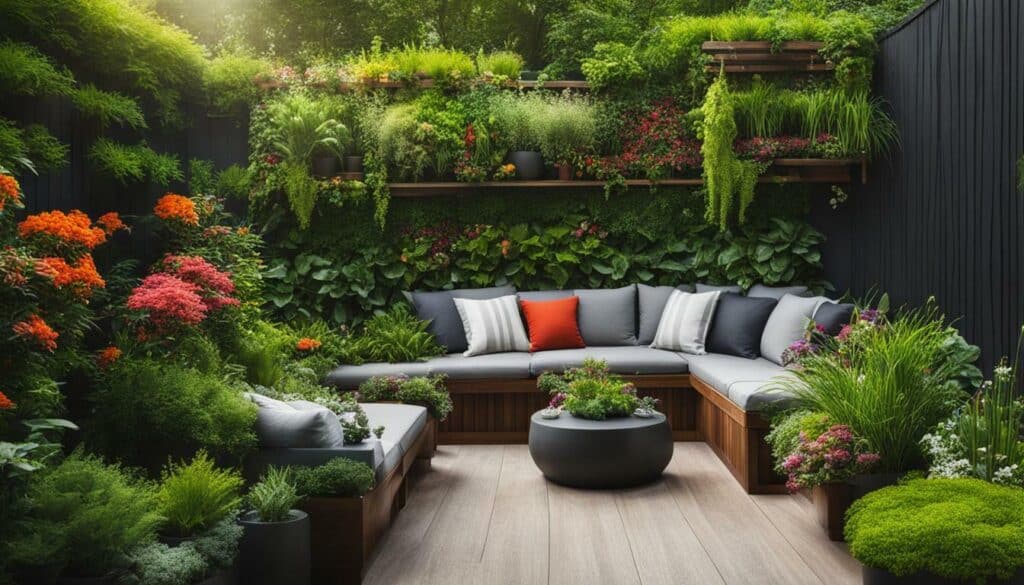
With consistent care and attention, your small garden will thrive and provide you with a bountiful harvest. Remember to water deeply, control pests organically, and harvest your vegetables at the right time. Enjoy the satisfaction of nurturing your garden and savor the delicious rewards of your own homegrown produce.
Expert Tip: Companion Planting
Consider utilizing companion planting techniques to enhance the health and productivity of your small garden. Certain plants have natural affinities for each other and can provide mutual benefits when grown together. For example, planting marigolds alongside your vegetables can deter pests, while basil can enhance the flavor and growth of tomatoes. Do some research to discover the best plant combinations for your garden and maximize its potential.
Enjoying the Rewards of Your Small Garden
Congratulations on your small garden journey! Discover the joys of harvesting and enjoying your own homegrown vegetables and herbs. There’s something incredibly satisfying about plucking fresh produce from your garden and knowing exactly where it came from. With a little time, effort, and patience, you can experience the flavors and nutritional benefits of homegrown goodness.
One of the best parts of having a small garden is the ability to customize your crops to suit your preferences. Whether you’re a fan of vibrant salads or hearty stews, you can grow a variety of vegetables that cater to your culinary needs. From crunchy lettuce and green beans to juicy tomatoes and zucchini, the possibilities are endless. Plus, having your own small herb garden means you’ll always have an abundance of aromatic flavors at your fingertips.
To make the most of your harvest, consider incorporating your homegrown vegetables and herbs into your favorite recipes. From simple salads and stir-fries to homemade sauces and soups, homegrown produce can elevate your dishes to new heights. The freshness and flavor will be unparalleled, adding a delightful taste that store-bought options simply can’t compete with.
So, grab your basket and head out into your small garden. Embrace the joy of picking fresh produce and savor the rewards of your hard work. With each bite, you’ll not only nourish your body but also feed your soul with the satisfaction of growing your own food. Enjoy the beauty of nature, the health benefits of fresh produce, and the pride that comes with cultivating a small garden.
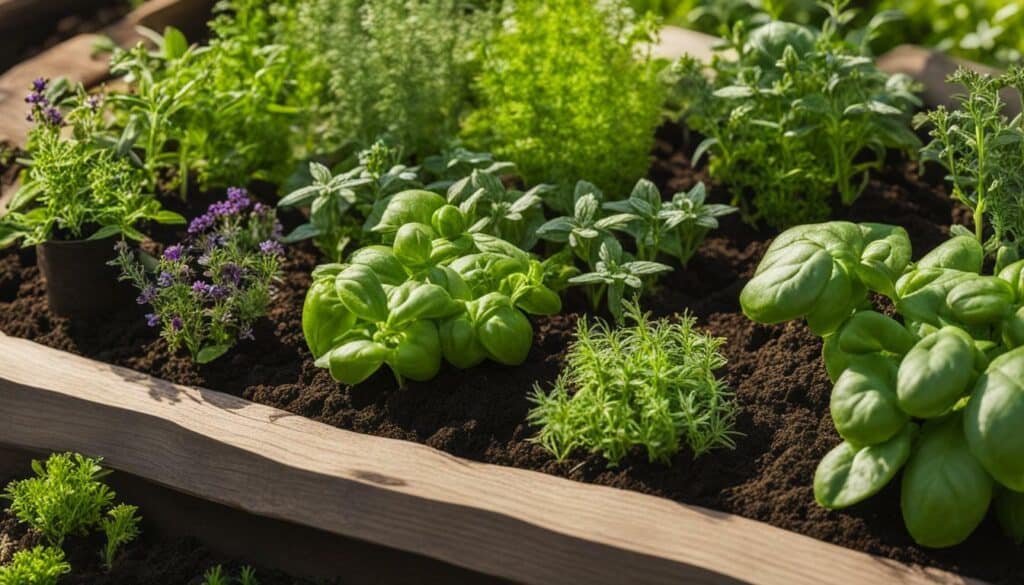
Small Garden Harvest Tips
- Harvest your vegetables and herbs when they are at their peak ripeness. This ensures the best flavor and texture.
- Use a sharp knife or pruning shears to carefully cut vegetables and herbs from the plant to avoid damaging the plant.
- For herbs, trim them regularly to encourage bushier growth and prevent flowering, which can affect flavor.
- Store excess harvest in a cool, dark place or consider preserving them through freezing, drying, or canning to enjoy them throughout the year.
- Share your bounty with friends, family, and neighbors to spread the joy of homegrown goodness.
| Vegetable | Harvesting Time |
|---|---|
| Lettuce | When leaves reach desired size |
| Green beans | When pods are firm and crisp |
| Tomatoes | When fully ripe and vibrant in color |
| Zucchini | When small to medium-sized for best flavor |
| Herbs (such as basil, mint, and parsley) | As needed, before flowering |
Conclusion
With the help of this comprehensive small garden planting guide, you are now equipped to create a thriving garden in even the tiniest of spaces. Get started today and watch your little outdoor oasis flourish!
To start your vegetable garden, choose a location with 6 to 8 hours of direct sunlight per day, well-draining soil, and stability. Mix in organic matter if the soil is thin and nutrient-poor. Start small with a manageable garden size, considering either planting in the ground or using raised beds. Select easy-to-grow and productive vegetables that you and your family enjoy eating.
Plant vegetables based on your regional climate and the specific planting times for each vegetable. Create a garden map and plan your beds, and either start seeds indoors or purchase transplants and seedlings. Make sure to have the necessary tools and accessories, such as a watering can and garden shoes. Take care of your plants, monitor for pests, and harvest regularly.
With dedication and proper care, your small garden will reward you with fresh, homegrown vegetables. Embrace the joy of growing your own food and enjoy the flavors and nutritional benefits of your harvest. Start your gardening journey now and witness the beauty of nature thriving in your own outdoor oasis!
FAQ
Q: Can I start a vegetable garden if I have limited space?
A: Absolutely! Even with limited space, you can create a small garden using containers, raised beds, or vertical gardening techniques.
Q: How do I choose the right location for my small garden?
A: Choose a sunny spot that receives at least 6 to 8 hours of direct sunlight per day. Ensure the soil drains well and is nutrient-rich. Avoid windy areas.
Q: What vegetables are suitable for small gardens?
A: Easy-to-grow vegetables that are productive in small spaces include lettuce, green beans, radishes, tomatoes (by transplant), zucchini, peppers (by transplant), beets, carrots, chard, spinach, kale, and peas.
Q: When should I plant vegetables in my small garden?
A: Planting times vary based on regional climate. Consult the USDA Plant Hardiness Zone Map and local gardening calendars to determine the best planting dates for your area.
Q: Should I start seeds indoors or buy transplants for my small garden?
A: Both methods work. Starting seeds indoors allows for more variety, while buying transplants saves time. Consider your preferences and the specific requirements of each vegetable.
Q: What tools and accessories do I need for my small garden?
A: Essential tools include a watering can, garden shoes, hand trowel, gardening gloves, and a gardening fork. Additional accessories like trellises or stakes may be needed for certain plants.
Q: How do I take care of my small garden?
A: Regularly water your garden in the early morning, maintain consistent soil moisture, watch out for pests and diseases, and harvest your crops regularly to promote healthy growth.
Q: What are the benefits of having a small garden?
A: Enjoy the rewards of fresh, homegrown vegetables, save money on grocery bills, experience the joy of gardening, and connect with nature right in your own backyard.
What are Some Plant Gardening Tips for a Small Garden?
Looking to cultivate a green thumb? Plant gardening tips can help you optimize your small garden. Start by choosing plants that thrive in your specific environment. Utilize vertical space by using trellises and hanging baskets. Pay attention to sunlight requirements and provide adequate watering and nourishment. Remember, regular pruning and cleaning will keep your garden healthy and flourishing. With these green thumb plant gardening tips, your small garden can become a vibrant oasis.

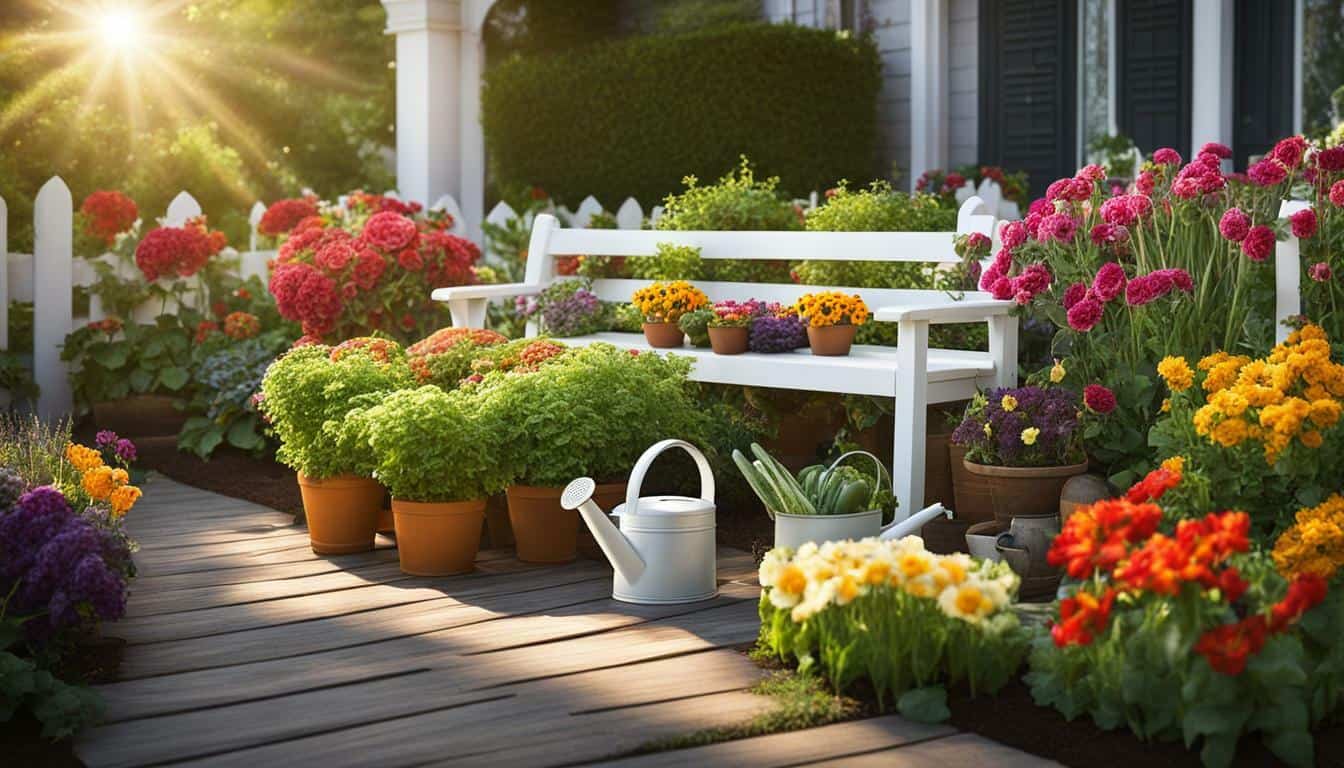



Leave a Reply